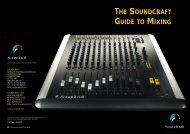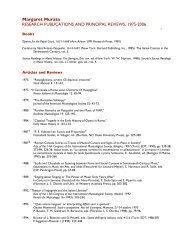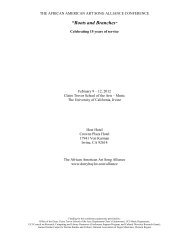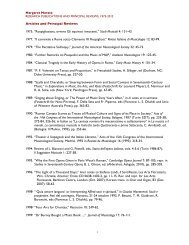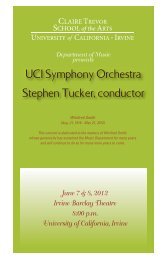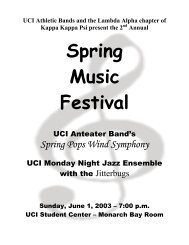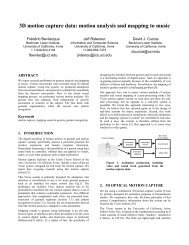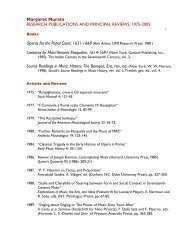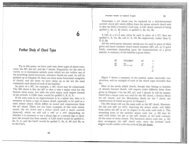What the GRM brought to music: from musique concre`te to ...
What the GRM brought to music: from musique concre`te to ...
What the GRM brought to music: from musique concre`te to ...
You also want an ePaper? Increase the reach of your titles
YUMPU automatically turns print PDFs into web optimized ePapers that Google loves.
190 Marc BattierThe idea of a symphony of everyday noises was alsoexpressed again and again in <strong>the</strong> first half of <strong>the</strong> lastcentury. Perhaps Schaeffer, a well-read man, wasfamiliar with <strong>the</strong> lines that Apollinaire had devoted inhis fiction Le Roi-Lune <strong>to</strong> a novel transductiontechnique which King Ludwig II of Bavaria hadinvented using multiple microphones?[The Moon-King] was seated in front of a keyboard, onekey of which he was applying with a weary air; and itremained stuck, so that <strong>the</strong>re came <strong>from</strong> one of <strong>the</strong>pavilions a murmur both strange and continual. At first Iwas unable <strong>to</strong> discern its meaning. The well-developedmicrophones which <strong>the</strong> king had at his disposal wereregulated in such a manner as <strong>to</strong> bring in<strong>to</strong> <strong>the</strong> cellarnoises of life on earth <strong>from</strong> <strong>the</strong> most far away places. …Now it is murmurs <strong>from</strong> <strong>the</strong> Japanese countryside 2 …Then, <strong>from</strong> ano<strong>the</strong>r depressed key, we are transported inmid-morning, <strong>the</strong> king hails <strong>the</strong> socialist hard work inNew Zealand, I can hear <strong>the</strong> whistling of geysers …Doum, doum, boum, doum, doum, boum, doum, doum,boum, it is Peking, <strong>the</strong> gongs and drums of <strong>the</strong> patrols …The king’s fingers run over <strong>the</strong> keys, haphazardly, raising<strong>the</strong>m up, in some fashion simultaneously, all <strong>the</strong>murmurs of <strong>the</strong> world have just been made for us, aswe remain stationary, a <strong>to</strong>ur by ear. 3Apollinaire called this group of living and naturalsounds <strong>from</strong> diverse sources a ‘symphony made by <strong>the</strong>world’. 4The meteoric development of cities and industrialisationstruck artists’ and <strong>music</strong>ians’ imaginations veryforcibly at <strong>the</strong> turn of <strong>the</strong> twentieth century, precipitatinga waterfall of movements (<strong>the</strong> ‘isms’) which <strong>to</strong>okhold of <strong>the</strong>m. With this, sounds <strong>from</strong> <strong>the</strong> world becamepresent in and part of composition: <strong>the</strong> sounds ofmachinery which led Luigi Russolo <strong>to</strong> his famousclassification, 5 <strong>the</strong> birds which inspired Messiaen, <strong>the</strong>zoo<strong>music</strong>ology of Francois-Bernard Mâche, <strong>the</strong> sirensand sound masses of Varèse – <strong>the</strong> examples arenumerous and very varied. And for Jean-EtienneMarie, Schaeffer was defined as a ‘naturalist withnature’s sounds’. 6 All <strong>the</strong>se approaches share in <strong>the</strong>irvery different ways a holistic vision of <strong>the</strong> creativeimagination.This interest in <strong>the</strong> sounds of <strong>the</strong> world is <strong>the</strong> pivot onwhich concrète invention turns, and beyond that, also agreat part of electroacoustic <strong>music</strong>, even if a significant2In an earlier version Apollinaire had written ‘<strong>to</strong>us les chants’ (‘all<strong>the</strong> songs’) before changing it <strong>to</strong> ‘<strong>to</strong>utes les rumeurs’ (‘all <strong>the</strong>rumours/murmurs’).3Guillaume Apollinaire. 1977. ‘Le Roi-Lune’ (1908–1916). InMichel Décaudin (ed.) Oeuvres en prose completes, volume 1.Paris: Gallimard, pp. 313–16.4Ibid., p. 316.5Luigi Russolo. 1913. L’Art des bruits. The edition edited byMaurice Lemaître and published by Richard-Massé (1954) is ofinterest for its famous (and unjustified) attack on Schaeffer by <strong>the</strong>essayist; <strong>the</strong> classification appears on p. 37. One may profitablyconsult <strong>the</strong> critical edition edited by Giovanni Lista, 2001, Paris:L’âge d’homme.6Jean-Etienne Marie. 1976. L’homme <strong>music</strong>al. Paris: Arthaud, p. 19.proportion of it is based on composition <strong>from</strong> syn<strong>the</strong>ticsounds. We need not concern ourselves here with soundlandscapes, which would be simplistic and more thanthat, false, but chiefly with what Schaeffer himselfdescribed thus: ‘The sound object, which may be anypossible audible sound, is that which ranges <strong>from</strong>natural sounds <strong>to</strong> <strong>the</strong> noises of civilisation, <strong>from</strong> animalcries <strong>to</strong> human words’. 7 That is <strong>to</strong> say, one takes externalsounds, and harnesses <strong>the</strong>m <strong>to</strong> ensure <strong>the</strong>ir transduction.The instruments adapted <strong>to</strong> this effect are: <strong>the</strong>microphone, or, more widely, <strong>the</strong> membrane that issensitive <strong>to</strong> acoustic vibrations and reconstitutes <strong>the</strong>m,through conversion, in<strong>to</strong> ano<strong>the</strong>r shape – mechanicalfor <strong>the</strong> first gramophones, electric <strong>the</strong>reafter; and <strong>the</strong>recording and playback machine. Each of <strong>the</strong>se stepshas contributed <strong>to</strong> modify our perception of sounds,and where <strong>the</strong> need arises, <strong>to</strong> transform <strong>the</strong> sounds<strong>the</strong>mselves. For that, one must first become a ‘phonographistartist’.3. THE PHONOGRAPHIST MUSICIANApollinaire was <strong>the</strong> first <strong>to</strong> declare that <strong>the</strong> gramophonecould become <strong>the</strong> instrument through which he wouldcreate a ‘vertical’ poetry, not declama<strong>to</strong>ry but withsimultaneous action. He <strong>the</strong>n proclaimed himself <strong>to</strong> be a‘phonographist poet’. 8 The gramophone, an apparatusconceived for recording and reproduction, is intriguing,and one finds a considerable amount of people whocame upon <strong>the</strong> idea that it should be used as aninstrument for creation. In 1931, Boris de Schloezerexpressed <strong>the</strong> opinion that one could write for <strong>the</strong>gramophone or for <strong>the</strong> wireless just as one can for <strong>the</strong>piano or <strong>the</strong> violin. 9 The <strong>music</strong> critic André Coeuroy, inhis 1928 Panorama of Contemporary Music, wrote‘perhaps <strong>the</strong> time is not far off when a composer will beable <strong>to</strong> represent through recording, <strong>music</strong> specificallycomposed for <strong>the</strong> gramophone’. 10 For Henry Cowell,referring <strong>to</strong> <strong>the</strong> projects of Nikolai Loptatnikoff, <strong>the</strong>rewas no doubt that ‘<strong>the</strong>re was a wide field open for <strong>the</strong>composition of <strong>music</strong> for phonographic discs’. 11 EvenIgor Stravinsky, who never created an electroacousticwork, declared in 1930 in <strong>the</strong> revue Kultur undSchalplatte ‘There will be a greater interest in creating7Pierre Schaeffer. 1976. ‘La <strong>musique</strong> par exemple’. Cahiersrecherche/<strong>musique</strong> no, 2, Le Traité des objets <strong>music</strong>aux 10 ansaprès, p. 58.8Guillaume Apollinaire. 1991. ‘A propos de la poésie nouvelle’, Paris-Journal, 29 juin 1914. In Pierre Caizergues and Michel Décaudin(eds) Oeuvres en prose complètes volume 2. Paris: Gallimard, p. 982.9‘Can we compose special <strong>music</strong> for <strong>the</strong> phonograph and <strong>the</strong> radioand thus create a new art? As long as we consider <strong>the</strong> record onlyas a ‘‘pho<strong>to</strong>graph’’, we compare it <strong>to</strong> <strong>the</strong> original and condemn itwhen it varies <strong>the</strong>re <strong>from</strong>. But even <strong>the</strong>se differences can acquirean aes<strong>the</strong>tic value.’’ Boris de Schloezer. 1931. ‘Man, <strong>music</strong> and <strong>the</strong>machine’, Modern <strong>music</strong>, 8 (3): 9.10André Coeuroy. 1928. Panorama de la <strong>musique</strong> Contemporaine,édition revue et augmentée. Paris: Kra, p. 162.11Henry Cowell. 1931. ‘Music of and for <strong>the</strong> records’, Modern <strong>music</strong>8 (3): 34.



